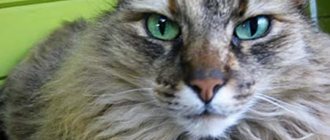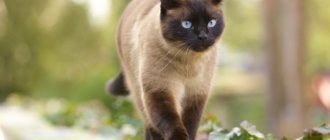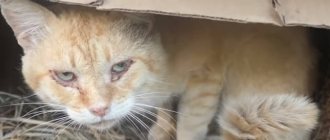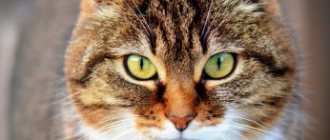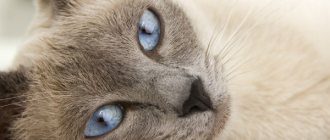The Serval cat breed is one of the most expensive and rare in the world. This is a wild African cat that was tamed and made domestic. Keeping a Serval is considered a luxurious and prestigious pleasure that not everyone can afford. It looks absolutely like a wild predatory animal, otherwise it is also called a bush cat. These animals are closely related to the caracal and lynx. When free, they live in forests and steppes, catch mice, hares, fish, shrews, reptiles, birds and are constantly on the move.
Servals are impressive, outrageous and truly exotic pets. Due to the similarity in character and habits with dogs, these animals are becoming increasingly popular all over the world. After all, the combination of the devotion of a faithful dog with the feline grace and wild color of the cheetah makes this animal unique. A similar skin is found only in cats of the Savannah breed, which are bred by crossing the Serval with a regular domestic cat, and in Bengal cats.
While walking with the Serval, his owner will always be the object of attention, because it is very surprising how this wild-looking cat brings a ball or walks on a leash. Many people dream of such cats, and owners jokingly call them “cotops” or “mini-cheetahs.”
Serval is a cat that emphasizes the image and high wealth of its owner. Some businessmen even take these pets with them to business negotiations to give them a special atmosphere.
Description and features
The name of the breed, "serval", comes from the Portuguese language. This is exactly what the French naturalist Georges-Louis Leclerc, Comte de Buffon, in 1765 called an unusual spotted cat that he saw in the royal menagerie at Versailles. The Latin name of the serval genus, Leptailurus, comes from Greek and translates as elegant cat.
The breed was first described by the German naturalist Johann von Schreber in 1776, and received the scientific name Felis serval. In 1858, Russian zoologist and traveler Nikolai Severtsov proposed separating the animal into a separate genus Leptailurus (servals). The scientific name Leptailurus Serval has stuck to the animal to this day. The serval is the only representative of the genus.
Morphologically, the serval's closest relatives are the caracal and the African golden cat. Together these 3 species make up one of the 8 branches of the Felidae family, the subfamily Small cats. Their common ancestor appeared in Africa approximately 8.5 million years ago.
Maintenance and care
To care for an animal comfortably, you need a lot of free space, so large rooms with open doors are a must. Being a nocturnal predator, the Serval cat is most active in the dark, at which time it is better to fence the animal with a special enclosure or put it in a cage. In the room where the serval cat lives there should be no fragile objects, wires or electrical appliances, as cats have good jumping ability and can damage expensive things.
Servals can easily be trained to use the toilet, but you need to keep in mind that the males of this species like to mark their territory. This problem is solved by castration. To maintain a good appearance, it is recommended to comb cats using a brush with natural bristles or special mittens. Pets can be bathed once every 2 weeks, without using special shampoos or detergents. To care for the litter box, it is better to purchase large-sized cat litter.
When moving or traveling, you need to remember that servals do not accept strangers and to transport the animal, you will need a special portable cage.
Species and hybrids
Throughout the 19th and 20th centuries, scientists identified 6 subspecies of the animal, depending on the color and habitat of the wild cat. Since 2017, the International Union for Conservation of Nature recognizes only 3 subspecies of the predator:
- L.s. server. Lives in South Africa.
- L.s.
constantina. Lives in West and Central Africa. - L.s.
lipostictus. Habitat: East Africa.
In 1986, the first kitten was born from a male serval and a female domestic cat. This is how a new hybrid cat breed was developed - the Savannah. The Savannah cat is noticeably larger in size than domestic cats, and resembles a serval in color. Savannah is a good swimmer and has inherited the peaceful nature of domestic cats.
There are also hybrids of serval and caracal - servicals and caravals.
Stephanie and Toby
Anna always preferred big, wild cats. When she had the opportunity to have her own pets, she chose servals.
Savages from Africa are distinguished by their curiosity and intelligence. In childhood, the animals are easily tamed and willingly make friends with pets.
When the kittens were small, the girl specially bottle-fed them with formula milk, gave them raw meat and treats by hand. So the growing kids mistook her for their mother and the leader of the family - this is the main rule in taming wild or semi-wild animals.
The owner pays a lot of attention to joint games, walks, and activities: kitties love to walk in winter and summer, especially in the forest, where they can, forgetting about social imposing, even climb a tree.
Wild genes in the blood do not allow cats to be lazy, so Stephanie and Toby, instead of hunting for game, enthusiastically play with any objects. Entertainment can be: raw potatoes, empty bottles, rubber balls, household items.
Anna doesn’t buy children’s toys for her pets, because sharp claws and teeth quickly turn balls and dolls into rags, but durable items for dog fun are what they need.
According to Anya: her pets became obedient, affectionate and very kind cats thanks to constant communication. After all, in order not to leave her furry pupils alone at home, the girl even takes them with her to work.
Stephanie and Toby have a job at the pet store: demonstrating harnesses, testing the durability of cat and dog toys, checking the softness of beds and pillows. During breaks between filming, cat models take an important rest in front of the public.
The “expert abilities” of popular kisuns evoke delight and trust among numerous buyers. Manufacturers of pet furniture donated personalized scratching posts especially for the feline couple.
Dimensions and appearance
The Serval is a lithe and graceful medium-sized cat. The predator reaches a height of 54 to 62 cm at the withers, and weighs from 8 to 19 kg. The body length of the animal with the head is from 66 to 100 cm, plus a tail about 30-40 cm long. Females are usually inferior to males in size, plus males are more firmly built and stocky. The animal is distinguished by a small head, disproportionately large ears and very long limbs. The serval has the longest paws relative to body size among all cats. The reason is the elongated bones of the foot. The toes are also elongated and unusually mobile.
Serval eyes are usually brown or green. The ears are very large relative to the size of the head, black in color with a white stripe in the middle. A white spot on a black background on the back of the ear is a false eye, protection from attacks from predators from behind. The predator can rotate its ears 180 degrees, and move each ear individually.
In terms of build and color, the serval is in many ways reminiscent of a cheetah - it also has a flexible, elongated body with long limbs, but the serval is significantly inferior to the cheetah in size.
The serval is similar in size to the caracal, but the caracal has a denser build, shorter legs, spotless fur and tufts on the ears, like a lynx.
With large ears, the serval is similar to the jungle cat - both species have developed hearing and long limbs to adapt to hunting in dense swampy thickets.
Description of Serval cats
The domesticated Serval, a proud representative of the African continent, allows its many admirers to enjoy the sight of its African elegance coupled with a truly wild appearance.
Yes, it is a predatory animal, so it looks as if it is ready to start hunting and attacking at any moment.
The breed standard of servals has not yet been finalized, but specific features stand out due to the very nature of the animal:
- Serval kittens have small heads. The ears, when compared with the rest of the body, look large. They are set at a sufficient height, and there is a thick edge on the inside of the ears. On the outside they are covered with stripes of black and white shades:
- the nose is quite wide;
- the eyes are almond-shaped;
- The mustache pads are very obvious and stand out, a mustache is a mandatory attribute of appearance, it is thick and long.
- In terms of size, the serval's body is quite small, especially when we compare this cat with other wild cats living in Africa. If we talk about the similarity with the most common domestic cats, then servals seem simply gigantic. The length of their body can be more than one meter.
The serval's tail is short and plump.
Cats belonging to this breed seem to be created to be models. They have the longest legs of all cats (in proportion to the body), and the length of the hind legs is greater than the length of the front ones.
All the differences that were described above are obvious, but this is still not a complete list of the features of these animals. These “crumbs” weigh from eight to eighteen kilograms.
- The description of the serval's coat is similar to the description of the coat of a cat such as a cheetah. The fur has beautiful large spots that merge into stripes closer to the back of the animal. Light shades can be seen on the face, belly and chest. The color of the fur itself can be very diverse: from the color of sand to a red-brown hue.
The coat is short in length, very soft, dense and shiny.
Serval color
The color of the animal varies from golden yellow to gray and beige. There are also black melanistic animals. In the mountains of Kenya, black servals make up up to half the population.
The entire skin of the serval is abundantly covered with dark stripes and spots of various sizes. Predators living in open spaces have lighter fur and larger spots. Forest servals have smaller spots and a darker color.
There are 3-4 dark stripes along the back of the head to the shoulders, which are then divided into separate spots. The fur on the throat and belly is light or white. The fur on the belly is long with a thick soft undercoat. On the back and sides the hair is about 3 cm long, on the head the hair is very short, no more than 1 cm long.
Description, photo of the serval
The body of the animal is long and slender - from the head to the base of the tail, an adult is 59-92 cm long. The tail is short in relation to the size of the body, its length is 20-45 cm. Height at the shoulders is 54-66 cm. Males are usually larger, their weight is 9-18 kg, females weigh 7-12 kg.
The serval's yellowish or orange-brown fur is covered with dark spots and stripes, the size and location of which vary greatly between individuals. The markings begin at the top of the head, extend between the ears and down the neck, forming four distinct stripes that break into spots as they reach the shoulders. The fur on the belly is white or cream-colored and also very thick and fluffy. The beast's tail is surrounded by black rings and ends with a black tip.
The location and size of the spots and stripes varies from one individual to another, however those servals found in grassland habitats tend to have larger black spots than those found in wooded areas.
Servals are distinguished by their small, graceful head, elongated neck, long legs (the longest of any cat relative to body size), and rounded ears, which are also the largest in relation to body size.
Long legs and neck, as well as large ears help the serval when hunting.
The eyes are almond-shaped, light, the nose is black, the bridge of the nose is quite wide.
In the photo, a serval shows off its teeth.
Character and lifestyle
Servals have good hearing, vision and sense of smell. Animals are active both during the day and at night, with peak activity periods occurring at sunset, dawn and dusk. On cold and rainy days, servals are more active; during hot periods, the animals prefer to rest in dense vegetation. Every night, the predator travels from 2 to 4 km in search of prey. Like other wild cats, servals lead a solitary lifestyle and avoid their relatives, with the exception of mating periods.
Both females and males live within their own hunting grounds. The site size averages from 10 to 32 square kilometers, depending on the terrain and the density of potential mining. The hunting territories of different individuals may overlap, but servals usually avoid each other and are not inclined to aggressively defend their territory. Predators mark their area with saliva, urine and excrement. Servals tend to be sedentary and rarely go more than a couple of kilometers outside their territory.
Servals actively avoid hyenas and wild dogs. When meeting them, predators hide in the thickets or run away, fluffing their tails, pressing their ears back and often changing the direction of their run.
The serval is quite good at climbing trees, although it does not do it often. Fleeing from pursuers, the predator can climb a tree to a height of 9 meters and above. The animal is very jumping and can jump up to a height of up to 3 meters, knocking down birds on takeoff.
Serval character
Servals are endowed with a wild and determined character, which must be tamed with the utmost correctness.
- The Serval cat breed is playful and sporty. African predators are accustomed to running and jumping. They love to jump onto high places and sit there. This needs to be taken into account and fragile and valuable items removed from shelves and cabinets.
- The character of the African serval will help you understand the similarities with the dog.
- The animal quickly gets used to walking on a leash. If the owner has training skills and patience, the cat will learn to carry out complex commands.
The predator shows friendliness only to animals of equal size. If you are close to canaries, a kitten or small dogs, the hunting instinct still wins, and other pets simply do not survive.
Servals have a much stronger tendency to damage furniture than other cats. They not only sharpen their claws, but also chew furniture. They like to pick, turn over or knock over objects. The serval needs space and room to roam.
The Serval cat is not stress-resistant and does not tolerate scandals.
It’s hard to believe, because they are a predator and a wild animal, but servals are distinguished by strong affection, trust and love for their owner.
Serval photo
Servals are sociable and the owner’s dislike is a great punishment for them. They are sensitive to words and intonations in their voice. Resentment and sternness in the voice are perceived by the cat as punishment and reluctance to communicate.
According to owners' reviews, the Serval cat is curious and friendly, she likes to explore and guard her territory.
Where does the serval live in the wild?
In the wild, the serval lives exclusively in Africa. In northern Africa, the animal is practically not found - a small population exists in Morocco and Tunisia, and in Algeria the animal has already disappeared. Sub-Saharan is found in the Sahel region, and is widely distributed south of the Sahel region across southern, eastern and western Africa.
The serval avoids tropical forests and arid areas. The predator prefers pastures, savannas, swampy areas, wastelands, bamboo thickets and cork oak forests. Found on Mount Kilimanjaro at altitudes up to 3,800 meters. The cat's favorite habitat is near a body of water, such as wetlands (wet land), or a savannah with tall grass as natural cover.
Health
The optimal age for purchasing a kitten is 5 months. By this time, he manages to get stronger, learn all the necessary skills and, thanks to breastfeeding, acquires strong immunity. In the future, servals must be vaccinated using exclusively non-live vaccines.
The long and thin limbs of small pets are very fragile, cannot withstand heavy loads and are easily injured. Their activity should be somewhat limited and they should not be allowed to frequently jump from high surfaces.
“Stool” deserves special attention: it should be regular, formed, 1 – 2 times a day. Liquid bowel movements several times a day or more lead not only to rapid dehydration, but also to very sad consequences. If serious symptoms appear, you should immediately seek help from a veterinarian.
Young animals are castrated and sterilized: males at 7-8 months, females at 12 months. Life expectancy in captivity is 15 - 20 years. Wild servals live up to 10 years in the wild.
What does a serval eat?
Like other wild cats, servals eat meat. The main food of the serval is small rodents, small birds, frogs, reptiles and insects. 90% of prey comes from small animals weighing up to 200 grams. On occasion, the serval also hunts larger game - hares, small antelopes, flamingos, duikers. At least 80% of the predator’s diet consists of rodents, mainly African mice and rats.
Servals search for prey by hearing. Predators jump on small animals and stun them with a blow of their paw, then kill them with one bite and immediately swallow them. Serval snakes are often eaten while still alive. Wild cats ambush larger prey, hares or birds, chasing them down with quick jumps and preventing them from escaping. Servals can jump up to 3.6 meters in one bound.
The predator eats large game slowly, so it often drags it into the thickets and leaves the remains for later. Carrion is eaten very rarely. Before eating the victim, the cat usually gets rid of the feathers, and sometimes the entrails.
Servals are excellent hunters - regardless of the time of day, about 50-60% of hunting attempts end successfully. In 24 hours, a predator can kill up to 16 different animals.
Description of the breed
Serval is a predator of the cat family. There are 14 species of servals, depending on their habitat and color.
The cat's appearance is camouflage for tall grass and bushes.
The serval's color is reddish-gray, covered with black spots and stripes. The lower part of the muzzle, chest and belly are white with dark spots. The thick short coat is smooth and soft.
The length of the slender body is 60-100 cm with a small dense tail of 20-45 cm. The weight of the animal reaches 16 kg. The head is small, elongated and with a wide nose. The height of the animal at the withers is up to 60 cm.
The serval cat differs from its counterparts in having long legs. The hind limbs are longer, which makes it possible to make large jumps. The structure of the legs is explained by the need to hunt in tall grass and find prey.
Serval - hunter
In addition to being tall, the serval has large, high ears, well-furred inside. They are also necessary for hunting. The main prey is small rodents, the rustles of which need to be caught.
The nocturnal predator hunts small animals with a body weight of no more than 200 g (90% of prey), mainly rodents. Its prey list includes lizards, snakes, hares, frogs, hyraxes and insects. The hunt begins with a stationary stance for 15 minutes, when the serval listens to the rustles of the night. When sounds appear, the serval jumps for prey. During the hunt, the cat climbs trees and undermines holes.
The Serval cat is unusually active. The standing jump reaches 3.6 m in length and 3 m in height. When jumping high, the predator is capable of knocking down a bird in flight. Due to its long legs, the serval reaches a speed of 80 km/h. The serval needs high speed when hunting antelope, gazelles and other ungulates.
Serval at home
In half the cases, the serval returns from hunting with prey and is considered a very successful predator. For example, lions have a 30% hunting success rate, while leopards have only a 38% success rate.
In natural conditions, the Serval cat lives 10 years, while in captivity it lives for about 20 years.
The serval can be tamed by humans, but only an animal born in captivity and accustomed to humans is suitable for keeping at home.
Reproduction and young
Both females and males reach sexual maturity between 1 and 2 years of age. Estrus in females lasts from 1 to 4 days, and occurs only twice a year, although if a female loses kittens, estrus can become more frequent up to 3-4 times a year. During estrus, the female attracts males with loud meows, scent and urine marks, then invitingly rubs her muzzle against the male's muzzle. Mating time varies depending on the animal's habitat. Kittens are most often born in winter, at the end of the dry season. Interestingly, throughout the population, servals usually give birth before mice do - apparently, they prepare for the hunt in advance.
A cat's pregnancy lasts from 2 to 3 months. One to four kittens are born in one litter. Females give birth in dense vegetation, or in the former den of a porcupine or anteater. Kittens are born blind and helpless, weighing about 250 grams and covered with gray fur, much darker than that of adults.
The cubs open their eyes on days 9-13, and within a month the female begins to feed them meat. To feed the kittens, the mother is forced to spend twice as much time hunting as single individuals without cubs. The cubs begin to accompany their mother on hunts early; after 6 months, when their molars appear, the kittens begin to hunt on their own. At the age of about 12 months, young servals leave their mother and go in search of their own territory.
Features of home maintenance
Domestic keeping of servals has a short history and the long path of domestication and selection has not yet been completed.
The smaller the kitten, the easier it is to tame. A small animal will form an attachment faster and easier, and bottle feeding will create a strong bond with its owner.
To raise a pet, you should hand feed a small Serval kitten. This is how a connection is developed with the appearance of the owner and pleasant expectations.
It is recommended to play with your pet on the floor in a lying or reclining position. What is important here is eye contact, located at the same level. This way the serval does not perceive humans as a threat.
Serval at home
Like all cats, the serval marks its territory. And he does this several dozen times an hour.
To avoid discomfort and unpleasant odor, it is recommended to sterilize cats at the age of 7-8 months, and cats at one year.
When raising a VIP cat, experts do not recommend doing the following:
- Let him play with his arms and legs to avoid future injuries. For this there must be toys.
- Yell at the serval. He understands commands very well.
- You should never hit. The animal will remember the offense and will not forgive.
- Reprimand for wrongdoing. The serval should be left alone. He will understand and come to repent.
Servals love water and need to be bathed more often.
In a house where there are small children under 5 years old, you should not have a serval. While playing, children pull the animal by the tail or ears and push. The cat will begin to defend itself and bite or scratch the child.
Natural enemies
Servals try to avoid all larger predators with which they coexist in the same territory. And lions, and leopards, and cheetahs, on occasion, may well kill a serval. The main enemies of animals in the wild are hyenas and wild dogs. Servals try not to catch their eye, and if they find themselves in close proximity to them, they immediately run away.
The main threat to servals is humans.
- The drainage of swamps and the development of new agricultural lands leads to a decrease in the natural habitat of the predator and a decrease in its food supply.
- The illegal trade in animal skins continues in Benin and Senegal.
- In West Africa, parts of the serval's body are used in traditional medicine.
- Many farmers shoot the predators to protect their livestock, although servals rarely hunt domestic animals.
Possible colors and varieties
The serval's coat color is pale yellow with black markings or large spots that consistently merge into longitudinal stripes on the neck and back. Some individuals have smaller spots, which makes them look like leopards. This color of servals is also called “crab”. They live mainly in West Africa. Early crab-faced servals were considered a separate species called "Felis Brachyura" until it was proven that this coat color was simply a variation of the common serval.
In addition to savannah servals, there are also forest representatives with darker fur and small spots. However, in nature you can find individuals with inverted fur; its feature is larger spots on brown coats and smaller ones on golden coats. Also in Kenya there are individuals with black fur. This color is the result of natural selection, since Kenyan servals live in mountainous areas. In captivity you can also meet white African servals with dark gray spots.
Population and protection of the species
The exact number of animals in the world is unknown. Servals are listed as a species of Least Concern on the IUCN Red List of Threatened Species. Hunting for the predator is completely prohibited in Algeria, Kenya, Congo, Botswana, Liberia, Morocco, Mozambique, Nigeria, Rwanda, and the Cape Province of South Africa. Restricted hunting is practiced in Angola, Burkina Faso, Central African Republic, Zambia, Democratic Republic of the Congo, Ghana, Malawi, Sierra Leone, Senegal, Somalia, Tanzania and Togo.
Meat gourmets
Raw meat is the main food for predators. Anna feeds her pets fresh frozen quail carcasses. The girl cuts the meat along with the bones using kitchen scissors. A domesticated cat eats about one and a half kg of meat with bones per day.
You can give your pets turkey, rabbit, ducks, and once a week - quail eggs. The housewife adds fish oil and mineral vitamins to the food, calculating the daily requirement based on the weight of the animal. Pets have free access to green grass; it helps purrs clean their stomachs of fur.
Boiled meat and canned food are not suitable for African purrs. "I!" - Anna says about them.
Serval at home
The serval is one of the few wild cats that are well tamed to humans and can live at home. If you take a kitten from an early age, preferably about 1-2 months, it will grow up to be completely tame. Servals are one of the most expensive cat breeds in the world. The price of a kitten from a cattery in Russia is about 0.5 million rubles.
By character, domestic servals are more like dogs than cats - they become attached to their owner and follow him everywhere. Servals are very energetic and playful, and you need to play with them and spend a lot of time with them. Cats are easy to toilet train and respond well to training. You need to feed your domestic serval with meat, from 0.5 to 1.5 kg per day. At first, it is better to hand feed the animal so that the cat becomes better attached to the owner and develops positive associations. You cannot hit an animal or shout at it - it is better to tame your pet with food (positive reinforcement) and a spray bottle of water (negative reinforcement).
Cost of a kitten
Purchasing and maintaining a Serval is a very expensive pleasure. You need to know this before purchasing. A serval in the house is a sign of wealth and status. But we should remember that this is not a soulless toy, but a vulnerable living creature.
The price of a kitten of this African predator is high. In Russia it starts from half a million rubles. In the United States of America, where most nurseries are located, it may be higher.
It is strictly forbidden to buy this cat from random people - there is a high probability of purchasing a sick animal from smuggled goods. To choose a kitten, you should come to the nursery yourself, talk with the breeder, make sure the health of the parents and baby, and deal with issues of proper nutrition and maintenance.
In our country, the rules for keeping wild animals at home are becoming stricter. Therefore, you need to make sure that the future pet is born from a female and a male located on the territory of Russia. Along with the kitten, you should receive its veterinary passport and certificate of origin.




